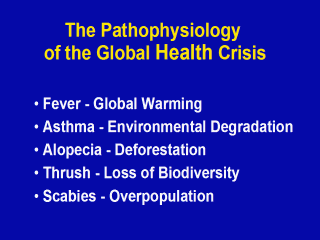| front |1 |2 |3 |4 |5 |6 |7 |8 |9 |10 |11 |12 |13 |14 |15 |16 |17 |18 |19 |20 |21 |22 |23 |24 |25 |26 |27 |28 |29 |30 |31 |32 |33 |34 |35 |review |
 |
As youíve
probably guessed by now, the patient is none other than the earth, our
collective mother, our home, our playground, and our spaceship. We are most
comfortable thinking about patients as individuals who together form
communities, populations that we can affect through public health
interventions. But today I want you to go one step further, and think about
the global environmental crisis, and its impact on our patients, their
families and their communities.
Why should we as public health practitioners and health services researchers and teachers take on the task of dealing with the earth as within our intellectual mandate? We are already overwhelmed by the work that we have been trained to do. The answer is simple, but chilling: if we donít address these global issues, all our other efforts will be in vain. Unless we can do something to reverse the pathological processes that are destroying the very substrate of life, it matters little how good we are at preventing injuries, promoting immunizations, or fostering healthy behaviors. And why are public health workers anointed to take on this additional burden? Because we have the curse of clear vision, and the responsibility to share that with an often reluctant public. Let me take you through the Pathophysiology of the disease that is afflicting our patient, and then explore some of the ways in which you and I can make a real, concrete palpable and immediate difference. |